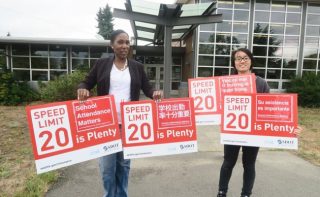
(Photo: Seattle Neighborhood Greenways)
Seattle transportation reform advocates are celebrating a major milestone this morning: last night Seattle City Council unanimously approved a measure that sets a default speed limit on some central city arterials of 25 miles per hour (instead of 30) and 20 miles per hour on all residential streets (instead of 25).
This is a big deal. Joshua Cohen reports on Next City that the new policy will effect a whopping 2,400 miles of neighborhood streets.
Portland’s biggest speed limit victory came in 2011 (and the 20 mph signs went up two years later) when the City and advocates successfully lobbied Salem legislators to pass a bill that gave the transportation bureau the authority to lower the speed limit five miles per hour (from 25 to 20) — but it only applies to streets designated as “neighborhood greenways”.
Advertisement
It passed! Seattle speed limits will be reduced to 20/25 mph. Thank you @sallybagshaw. Thank you @SNGreenways. Thank you @CascadeBicycle. pic.twitter.com/8oi6Kche2H
— Queen Anne Greenways (@QAGreenways) September 26, 2016
Sources in Seatte say their new policy came about for two key reasons: A change in state law in 2013 that made it easier for the city to set speed limits and advocacy groups who pushed city council to live up to their Vision Zero rhetoric.
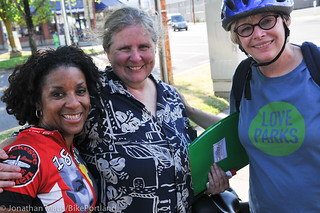
(Photo: J. Maus/BikePortland)
Seattle Bike Blog editor Tom Fucoloro told us via email last night that, “Originally, the city wanted to go street-by-street in implementing it, but they changed their tune in recent months after urging by Seattle Neighborhood Greenways.”
The nonprofit Seattle Neighborhood Greenways (with the help of other groups and Cascade Bicycle Club) worked for years on a “20 is plenty” campaign. SNG Executive Directory Cathy Tuttle told Next City that the law is a “giant step forward.”
Fucoloro was also quick to point out that lower speed limits “aren’t worth much” without street designs that force people to drive more slowly.
Interestingly, he also said last night’s unanimous council vote was long overdue given that a state law passed in 2013 all but paved the way. That law, dubbed the Neighborhood Safe Streets Bill, relieved municipalities of the burden of costly and time-consuming traffic studies previously required to earn a speed limit reduction from the state.
If that sounds familiar, you’ve been paying attention.
Cities and towns in Oregon must also go through an onerous process to request a speed limit reduction (on a case-by-base basis) from the State of Oregon. Similar to what Washington did in 2013, the City of Portland is trying to do now. As we reported last month our bureau of transportation has asked ODOT to sign off on an alternate methodology for setting speed limits.
PBOT spokesman John Brady told us this morning that PBOT traffic engineers recently met with ODOT and cleared up all the remaining issues and that, “We expect to receive the formal go-ahead soon.” Once the new methodology is in place, PBOT will be able to use it for a four-year period.
While far from a silver bullet given the state of enforcement limitations and auto-centric road designs; the power of passing lower speed limit policies is in what they do to traffic culture: They send a signal to road users about what type of behavior is acceptable and expected.
In a society where deviant and extreme driving behaviors are mainstream, safe driving messages — and policies to back them up — are essential ingredients for change.
— Jonathan Maus, (503) 706-8804 – jonathan@bikeportland.org
BikePortland is supported by the community (that means you!). Please become a subscriber or make a donation today.



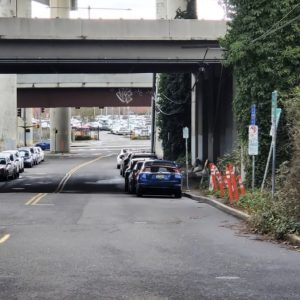
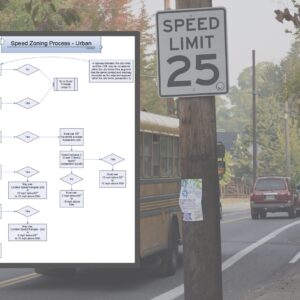

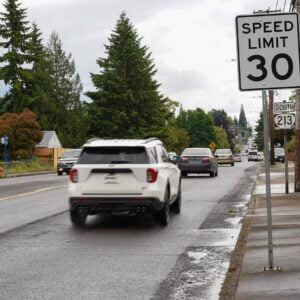
Thanks for reading.
BikePortland has served this community with independent community journalism since 2005. We rely on subscriptions from readers like you to survive. Your financial support is vital in keeping this valuable resource alive and well.
Please subscribe today to strengthen and expand our work.
Yes, please!
The authority to set temporary and emergency designated speeds is already there. Enough waiting.
Good news for Seattle. Portland could decide any minute to lead the way as soon as we get done catching up.
If this subject ever gets posted to the Oregonian, the amount of extra power it will take to keep their angry comments section up would be enough to power a small town.
Oh crap… the lights just dimmed…
The hot air could be harnessed to power some kind of steam-turbine type plant.
It is hard to believe that the state makes it very difficult for a city to lower a speed limit. Certainly makes you wonder who ODOT and the lawmakers creating such laws really serve. Certainly not the public interest of safety.
That law exists to avoid cities and towns creating “speed traps”; i.e. setting speeds in a way designed to ensnare drivers and raise revenue.
It’s not bad in theory — uniform traffic rules are good, but it doesn’t work out so well in practice if you are trying to change behavior and increase safety.
“That law exists to avoid cities and towns creating “speed traps”; …” h kitty
I doubt laws providing for state authority over city’s speed limits, were created to discourage use of speed traps. Some cities set them up, but most don’t, if it’s primarily for raking in dough. Quite a few years back, from down in southern Oregon, there was a big story about a smallish town whose PD was bringing in big bucks busting people for excessive speeds at point on the highway near the town. Eventually, the PD got busted for playing loose and fast with limits on its authority to issue citations.
Seems more likely to me that at least part of the reason the state has been granted(by us the people through our legislators.) authority over speed limits, is so the state will have some uniformity in that respect. Allows road users’ much easier knowledge of what mph speed will be for given types of road situations; through the countryside, through residential districts, through business districts, etc.
Another reason I think, is economic…so that roads and streets throughout the state can be managed for fast, efficient travel and transport by motor vehicle can be maximized. Lots of examples of diminishing returns are apparent with that philosophy handling today’s traffic among a dense population.
wsbob, although your description is a bit vague, I believe you are talking about the small city of Coburg, which is located in the Willamette Valley just north of Eugene along I-5. Their cops were patrolling I-5 and handing out speeding tickets as fast as they could write them until people caught on and slowed down. They weren’t slapped down for any malfeasance, the legislature altered the law, which stopped them.
Now, did their efforts result only in revenue? No, at least according to the former head of the Springfield police department who reviewed them. While he admitted to being skeptical, once he looked at the data that showed that the stretch of I-5 patrolled by the Coburg police was the safest stretch of I-5 in the state, he concluded that they were saving lives.
That should be no big surprise: lower speeds result in fewer collisions and fewer deaths and enforcement is a proven way of bringing this about. Unfortunately, Vision Zero is now going to be implemented without this essential and most effective tool, and that’s a bloody shame (pun intended).
I’m 100% for speed traps. And for lowering speed limits. Trap away!
What could be better for precluding “speed traps” than a uniform citywide speed limit? No one could say feign surprise if they entered Portland to a giant “Citywide 20 mph Speed Limit” sign. You’re welcome, Legislature.
The Seattle city council did this under political pressure and a liability for blood on their hands.
When the BTA is done renaming itself AND Allows members to vote on endorsements monkeys will fly and I might renew my lapsed 8 year membership.
Right now city hall denies our roads are a deadly design, and they censor #visionZero activists like me, PJ and Josh..
Not sure this statement from the article makes much sense.
“In a society where deviant and extreme driving behaviors are mainstream, safe driving messages — and policies to back them up — are essential ingredients for change.”
If deviant and extreme driving behaviour is mainstream ( I agree) it is going to take more than just a message to change things. I applaud Seattle for getting out ahead of Portland on this important issue, but I will give them a standing ovation if they can break the legal-budget logjam holding pack modern technical high-frequency enforcement of these laws. Extreme deviant drivers will not stop terrorizing the roads due to new signs and happy talk. We need ironclad enforcement to shut down their death race.
It’s going to take speed cameras all over the place. Fortunately, we finally have that tool as an option as well.
We should just have an app that detects when you are exceeding the speed limit on a street according to its speed limit and then deduct the ticket value from your account. Would be a win win.
Chronic speeders would have their cell phone batteries explode, like the Note 7!
I would totally install that.
are you saying we need policies to back up the messages?
Congrats! Beaverton has a 20 mph speed limit by the fancy car dealers on the north side of deadly TV Highway. It is 25 mph on the adjacent residential street to the east.
Yay, capitalism.
Who wants communism?
Is that the only alternative?
carmunism is what we have now
wouldn’t want any cars getting damaged, they’re worth more to them then people!
“….Beaverton has a 20 mph speed limit by the fancy car dealers on the north side of deadly TV Highway. It is 25 mph on the adjacent residential street to the east.” rick
Between which north-south cross streets? I used to drive quite a lot, west of Hocken to Murray…the section or part of the highway to which I’m guessing you’re referring…and might have noticed any recent change in speed limit, if I were still driving that section of the road.
Business activity to either side of the road is changing, for sure: lots more investment by car dealers in new, sleekly designed buildings.
Is this on streetview or something? I’d like to see this.
Nice. Hopefully I will be able to pull the plug from my grassroots “SLOW THE F**K DOWN” campaign.
“deviant and extreme driving”…well said.
our default speed limits of 20 in a business district and 25 in a residential show that we favor capitalism over people… if you’re not spending money you’re not important… it’s a slogan heard from drivers all the time: cars are money, bikes are leisure toys, peds are people walking to their cars…
Congratulations Seattle!
Now, please let’s see some studies of how this change might affect traffic safety. I’d imagine things will improve and that might just help getting the same power for Oregon municipalities.
While I applaud them for this achievement, this will do nothing. It may generate additional revenue for the city, via tickets, for like the first 6 months, but still the driving public will do nothing to abide by this. They don’t currently, so unless they have some way of physically slowing the vehicles this isn’t going to do anything. People just want to go faster and faster. However, I am optimistic, I hope this works.
But that’s the point.
Now we can get streets traffic-calmed that previously couldn’t have been, because the speed limit is low enough to make the violating behavior actionable!
Does the, as you put it “…the driving public…”, include any of your family members, friends, neighbors, and perhaps yourself? By way of informal, casual surveys through conversation with friends and family, I consistently hear from most of them that they are weary of people that are driving excessively fast through their neighborhoods. Their feeling may increasingly be the sentiment of the broader population as well.
Hopefully that’s true, and signifies the growth of a cultural change of philosophy in travel by motor vehicle, particularly through neighborhoods. I think more people will be supporting lower posted speed limits, and will voluntarily be reducing the mph speed of their motor vehicles to those limits, because they can, and because lower posted speed limits reduce pressure upon them to drive faster than they may actually want to be driving.
“because lower posted speed limits reduce pressure upon them to drive faster than they may actually want to be driving”
Exactly. Many people in my neighborhood want to drive 20, but feel social pressure (and tailgating) to drive 25+.
I’m less hopeful than you. I think many people hate it when other people drive fast on their own street but feel perfectly fine driving fast themselves on other people’s streets.
I live in a semi-rural Vancouver neighborhood with no sidewalks and lousy lighing and lines of sight. I take holding other drivers up on our little streets as a matter of pride!
Thanks for your optimism Odikira. I’m the ED of the advocacy organization that pushed for the 20sPlenty 25toStayAlive legislation. Our next order of business is to strongly push for funding to engineer Seattle streets to safer speeds.
Since the City has decided that traffic enforcement will play no role in Vision Zero, it’s hard to see the point.
The Admin Code only changes the method for investigating speed limit changes. The authority to change still rests with ODOT.
I live on a street with rampant speeding. It doesn’t really matter what the speed limit is. There is no enforcement. Furthermore, most streets don’t even have a speed limit sign. This is all wishful thinking.
I live on a street where I have checked speed of motor vehicles 35 is the limit. I have seen motorcycles go airborne past the house going over a gradual hill to a slight descent. Scholls Ferry at Red tail golf course. Other times I have seen rice rockets and SUV’s going by at speeds in excess of 70MPH. within 3 blocks we have had cars rear end pickup trucks, not in the bumper but the cabs missing the bed. Over the last 35 years.
Traffic is not getting any better. Just more of it with less enforcement.
How do you ‘see’ the speed of a car? Professionals don’t even make such claims.
I ask this out of pure curiosity, paikiala–I suspect you’re just a stickler for the facts but do you really not see any difference in the way people are driving in Portland nowadays? Do you not personally notice more speeding/reckless driving?
Sometimes ‘see’ means ‘witnessed’. Many people can judge speed fairly well as it is a helpful skill in traffic, some might even estimate speeds to within 1-2mph by counting seconds to cover a known distance. feet per second =~ 1.5*mph i.e. 52fps =~ 35mph (I calibrate my 3-second count by a trimet bus covering 150ft in a 25mph zone.)
I’m not a fan of blanket limits, especially such low ones. While 20 makes sense a lot of the narrow residential streets where space is tight and lots of things obstruct vision (the greenways are typically like this), it’s absolutely ridiculous for others. The limit should be based on a wide range of factors.
I feel safer when cars are going faster than me. When they’re going the same speed, they can pull into you because you’re in their blind spot. If they’re going slower, hooks become a greater problem. Riding fast near slow cars is just asking for trouble and 20 is just too slow.
There are places where the people regularly drive too fast. Having said that, I find myself wishing the cars were going faster a lot more often than I wish they were going slower.
It is not a blanket 20 mph limit.
http://www.seattlebikeblog.com/2016/09/27/council-approves-lower-speed-limits-but-the-work-isnt-done/
I think you are in the minority on this, Kyle.
I get that.
As a general principle, speed differentials cause problems and it’s easier to control what’s in front of you so you don’t want things taking you from behind.
However, because of the way visibility out of motor vehicles works, there are real benefits to speed differentials when you’re on a bike. Drivers are relatively good at seeing what’s in front of them, but they’re really bad at seeing what’s beside or behind them. Besides, even under normal circumstances, your real threats tend to come from the side and the front more often than the rear. That’s why there’s perpetual talk of being hooked.
To fully appreciate this dynamic, try taking a recumbent trike out in heavy traffic. When you’re beside a vehicle, the only thing that’s even at a level drivers can see is the flag if you have one. They often won’t see it and lights barely do anything as you get closer. When you come up from behind, you’re too low for them to notice. You have to be ready on an entirely different level than you can get away with on an upright bike. Bottom line — if you can’t pace traffic in the lane, your best and safest option is for drivers to go moderately faster than you so they can see and avoid you.
There is a similar dynamic with upright bikes, but it’s not as pronounced.
You should almost never ride next to motor traffic on a residential street. You need to control the lane.
That is only practical on smaller, slower, more lightly trafficked streets. And in all honesty, there’s no real safety issue on such streets. I always wave cars through since they’re not going to hit you if they’re paying enough attention to drive behind you. One problem I encounter in Portland is they often won’t pass even if waved through because they refuse to pass close even if you’re slowly grinding up a hill.
On busy city streets and highways, simply taking the lane is somewhere between unwise and suicidal. Don’t get me wrong. Riding left is important for visibility (yours and the motorists’) and to avoid encouraging unsafe moves. But riding safely requires adapting to actual conditions. There are tricks you can use to herd the cars behind you or otherwise get them to behave without them even realizing it — very handy on two lane highways with no shoulder.
IMO, safety has much more to do with flow and predictability than space.
Kyle, based on your comments I have come to the conclusion that when it comes to riding in urban traffic I often do the opposite of what you advise. Yet…somehow…after ~160,000 miles in the saddle I have yet to collide with a person or thing. I see two possible explanations for why my anecdotal experience is so different from your anecdotal experience:
1) I am leading a preternaturally charmed life.
2) There is more than one style of cycling in urban traffic that is generally safe.
Maybe he’s in he minority and maybe not. I agree with him. predictability of on-road behavior is key here, and my feeling (squishy, I know) is that cars moving at my bike speed are less predictable.
My other feeling is that there are going to be a lot of new faces on the Seattle City Council next term. I’m just back from a 2 hour stint counting bikes and peds at an intersection near Boeing Field and aggressively driving 30 yr old white guys in BMWs outnumbered cyclists at least 2 to 1.
Regardless of the positions of current riders, liking to ride sharing space with cars going faster than you is DEFINITELY in the minority of the significantly larger set of people who would like to ride but don’t.
That might be true. But there are nonintuitive aspects of riding I think people should at least consider.
Fear of cars is a major issue, especially with newer riders. But we need to quit kidding ourselves. People say that’s why they don’t ride, but the reality is that there are many reasons, that being only one of them.
For example, when I lived at Macadam and Pendleton, people in the condo complexes there often eat at Aquariva which is close by and decent. You can easily walk there on the greenway path or bike there in just a few minutes. But people practically always drove despite the fact the parking situation was hopeless. Despite having noncar options completely isolated from cars that were safer, more scenic, and faster than driving, people drive.
We have very little control over what the motorists do, but we have lots of control over how we interact with our environment. So rather than fixate on what the drivers are doing wrong, it might not hurt to figure out what we can do to be safe and have fun in an environment that contains bad drivers.
It’s not all about you.
No kidding. It’s mostly about me.
You might be understating that.
🙂
There’s minimal, if any, enforcement on our Greenways as it is. While I applaud the possibility of dropping the limit on all neighborhood streets, without enforcement, it really doesn’t matter.
With Greater Portland’s record consultants hired by the individual Commissioners to make any kind of decision on ever changing any speed limits or doing any safe things where some out 0f state trucking company might be inconvenienced traffic safety improvements and Vision zero action. It will be at least 2030 before the outside consultants make the decision since when they do they no longer make any money.
Oregon’s statutory speed discrepancy–20 in business districts and 25 in residential districts–creates danger where families live, messes up traffic flow, and enables “speed traps.” Let’s fix it!
Sounds great but with no enforcement useless. We already have 20 mph posted on many of the streets in my area but blantantly ignored.
If I see a street posted at 20mph, I drive 20mph. And so does everyone stuck behind me.
if i see a street posted at 30 mph, i drive 20 mph.
(hi there, burnside and 20th!)
I have mixed feelings about this since I rather not drive 20 MPH on NE Marine Drive or parts of OR 99E. I can see the good intentions are our there just the brush is really wide.
If people want slower streets, there’s a super cheap and easy way to achieve this — just don’t maintain them very well.
Motorists don’t like driving fast on rough stuff, and it doesn’t take that many potholes to slow things to a crawl.
I would like to see a return to cobblestones.
And mountain bikes.
Me too… they’re really fun on a bike!
That’s why–mountain bikes! They go hand-in-hand!
The 20 is enough is a very good target. A good example was yesterday with the bridge debacle on I5. I had to take my wife from Washington Square to Kaiser on North Interstate. I knew that I5 was not moving when I took Multnomah but I also knew that Sunset was in gridlock so I did not go via Canyon. I passed 3 cyclists on Multnomah. They passed me on the I5/Terwilliger entrance. I passed them (just) before Naito. They passed me before Foothill. I went down 4th to Everett to Broadway. 2 of the same passed me on the ramp. I passed 1 on Interstate.
I was in gridlock most of the way and none of the cyclist went through red lights and neither did I.
20 Mph is a very reasonable speed for most of the way for Motorists. In traffic, at least from 7AM to noon and noon until 7PM. if the majority of traffic was restricted to 20 MPH it would at least flow smoothly.
There would undoubtedly be fewer fatal accidents.
Gotta love those “20 is Plenty” signs that the Seattle folks are modeling in the above photo. Those should be adopted for use here. The signs there (which are, I see, multilingual) refer in particular to school zones. I’d adapt them to read “For a safer Portland.”
Does this mean bikes would be restricted to 20mph?
Only gravity would control that. Don’t forget enforcement would be still giving a free ride to motorists of 10 MPH over.
I have clocked cyclists at 45 MPH+ on Canyon/Jefferson exit.
Good news…though it would be Great News!…if this were the same actual speed as the original “20 is plenty” in the UK…20 kph = 15 mph. ,-)
Sadly…my fellow british citizens are almost as resistant to the metric system as USAnians.
In NYC, it’s 25mph, citywide, except where posted otherwise (ie school zones). 20 on main streets, 15 on neughborhood streets and in school zones might be a good target to go for.
Want to become acutely depressed? Read the on line readers’ comments to this story in the Seattle Times. 20:1 against the new law. Disheartening.
I’ve seen stats that indicate pedestrians are roughly 2x as likely to die from being hit at 25mph vs 20mph, and 8x as likely to die at 30mph. Not to mention, it’s easier to not hit someone in the first place if you are moving slower.
I liked that safety campaign that said ‘Other people make mistakes. Slow down.’
Unless and until America’s urban planners get away from their fixation with straight-line street grids, there probably won’t be any significant drop in speeds. One of the reasons people speed is because the road design enables it. Residential areas made up of crescents and cul-de-sacs with a that feed onto avenues can do more to discourage speed demons. The residential streets could also be narrower. I know in parts of my neighborhood, the streets are so narrow that you can’t go faster than 15 – 20 mph because you are weaving between cars parked on both sides, and there is barely room to drive between the two rows of cars.
That said, it is difficult, but not impossible to change things after the fact. For example, N Williams between Ainsworth and Killingsworth is effectively a cul-de-sac thanks to street calming measures. While it is initially inconvenient to have to go “the long way around” after such measures are introduced, people get over it. During the planning phase, drivers will predict the end of civilization as we know it, but they will get used to it. We should be funneling through traffic onto main streets, not side streets.
How do drivers stay awake at 20mph? Sleeping drivers crash into all sorts of things.
Does the 20mph speed limit apply to bikes too?
Why not? I can stick to it if drivers can.